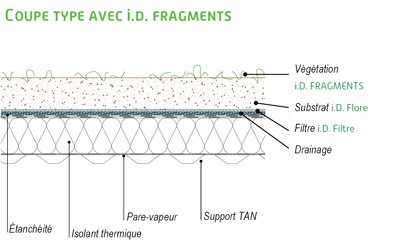For some green roof projects Vegetal i.D. suggests using i.D. FRAGMENTS sedum fragments (sedum cuttings without roots) intended to be sown on the growing medium. Once in contact with the growing medium, the cuttings will send out roots, then the plant will gradually develop and cover the roof. Early spring or the month of September is generally the best period to spread cuttings. This solution does not provide the roof with immediate plant cover; generally 18 to 36 months are needed, depending on the technique chosen, in order to obtain complete plant cover.
2 sowing techniques: manual and using hydraulic spraying
The i.D. Fragments sedum cuttings can be spread manually on projects with gently sloping roofs (up to 10%) covering a large area (over 1000 m2). The roof will appear covered after a period of between 18 and 36 months, the period needed for the cuttings to become rooted in the growing medium and for the plants to develop successfully.
The i.D. SURE process is a sowing process involving hydraulic spraying particularly well suited to greening large areas (over 2000 m2) and to roofs, which are difficult to access. i.D. SURE is able to vegetate roofs with an average pitch (under 20%). The i.D. SURE process combines water and sedum cuttings with appropriate seeds for providing perennial vegetation (seeds of sedum and selected perennials), a plant glue acting as a fixative to the growing medium and a mulch of plant fibres to protect the seeds and cuttings from water stress and erosion during the establishment phase. Once sprayed, the i.D. SURE solution coats the growing medium, holding the cuttings and seeds in place. It encourages the seeds to germinate, and the cuttings to put out roots. Plants are certain to grow, and the period for obtaining full plant cover is therefore shortened.
| Process |
Surface area to |
Plant varieties |
Pitch |
Use |
Total |
|
Manual sowing with i.D. FRAGMENTS |
< 2000 |
Sedums |
<10% |
Large surface area |
18 to 36 month |
|
Manual sowing with i.D. FRAGMENTS |
>1000 |
Sedums and perennials |
Up to 20% |
Very large surface area (> 2000 m2) or inaccessible roof |
18 to 24 month |
Diverse plant cover
i.D. Fragments cuttings contain about ten varieties of different sedums in order to ultimately obtain a pleasing and varied aesthetic appearance as well as good performance on the roof. The varieties used the most are: sedum sexangulare, album, lydium, floriferum and spurium.
The i.D. SURE process enables the variety of plants to be diversified by combining sedum seeds with perennial seeds.
Growing medium suited to the project
The composition of the growing medium is specifically suited to the technique of greening using seeds. The thickness of the growing medium in the planting system depends on the drainage layer and the technical constraints characteristic of the project (aspect and exposure of the roof, maximum load supported by the load-bearing component).
Easy to install
Greening a roof by spreading cuttings is the least expensive planting technique: it is not only easy to do, but it is also very quick.
 Standard section of a system of greening roofs by sowing i.D. FRAGMENTS sedum cuttings
Standard section of a system of greening roofs by sowing i.D. FRAGMENTS sedum cuttings
Very regular maintenance is essential during the establishment period
Using the technique of sowing sedum cuttings to green a roof requires more maintenance than the other techniques ((3 to 5 visits to the roof per year) throughout the establishment period (the time needed for the sedum cuttings to put out roots in the growing medium) and 18 to 36 months will be required before a covered appearance is achieved. Aesthetic appearance of a roof greened by i.D. SURE gel seeding. 1. During installation 2. After 8 months 3. After 1 year
Aesthetic appearance of a roof greened by i.D. SURE gel seeding. 1. During installation 2. After 8 months 3. After 1 year
.
Where can this be used
The various characteristics of the i.D. Fragments planting technique mean that this technique tends to be given preference for very large projects (over 1000 m²). For very large surface areas (over 2000 m²), the Vegetal i.D. team will study the possibility of spray sowing using the i.D. SURE procedure. This technique is quicker to implement and the sedum cuttings are more likely to root.
- On flat roofs or those with gentle pitches (less than 20%)
- On large surface areas to be greened (over 1000 m2) which do not require a particularly attractive appearance in the short term.




